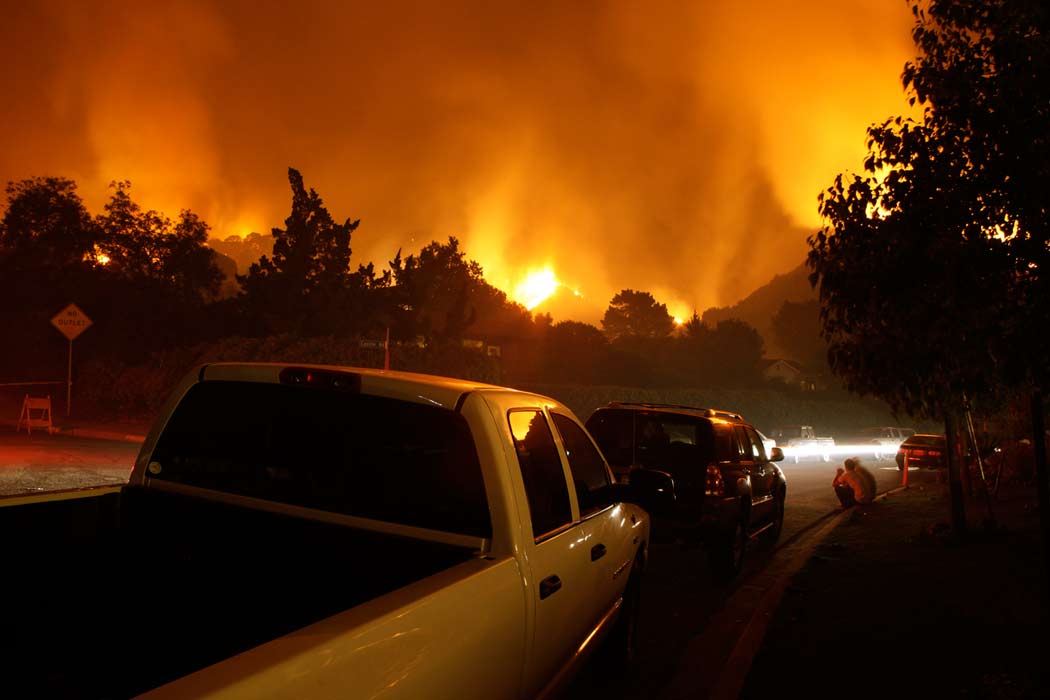If you live on the West Coast of the United States, you probably smell smoke right now. And if you live anywhere else, you’re surely reading about the wildfire infernos raging through thousands of forest and valley acres from California to Canada. NBC Los Angeles posted eerie pictures of cars caught in the blazes and burnt nearly to smithereens. Grist recently reported that the Pacific Northwest is looking a bit hellish too. And Climate Central wrote that British Columbia is having its second-worst wildfire season on record, with thousands of people having to evacuate.
Wildfires and Public Health
Charred cars, blackened fields ,and displaced residents are easy to picture. But there are other consequences of wildfires, less obvious but no less important: the overall effects on human health. When a 2011 study investigated the indirect effects of forest fires on human mortality in Greece, it found that small outbreaks were rather harmless, but the large-scale ones clearly contributed to the amount of deaths from cardiovascular and respiratory causes. Another study, conducted after 2003 California blazes burned over 750,000 acres of forest and winds carried the smoke toward Los Angeles and Orange counties, linked wildfires to slightly lower birth weights in infants. And as the weather continues to warm up, the wildfires will likely keep intensifying, posing more direct and indirect risks. As one of the recent public health papers noted, California residents should be prepared for “potential increases in the incidence of extreme events,” including wildfires.
Extreme events also include floods, which often happen after wildfires burn the land clean. As research shows, floods and mudslides can be caused by the rapid water runoff from the burnt and barren slopes—resulting in more devastation and chaos. The smoke is still hanging over the West Coast, but CBS has already reported flooding in Southern California, and Mercury News posted videos of cars floating in the impromptu mud rivers.
Predicting Floods
California has always been prone to floods, but these extreme weather events have increased and intensified over time, likely due to the population growth and human activity. Interestingly, recent studies found that flash flooding events in the western United States follow specific seasonal and diurnal patterns: they occur mostly in summer months and in mid-afternoons to early evenings. While scientists haven’t yet fully figured out the peculiarities of Mother Nature’s schedules, these observations can help keep the general public informed and ready. Imagine reading this on your iPhone weather app: “Sunny with a chance of smoke and midday mudslides.” Yes, this is how the 21st century West Coast summer forecast may look like one day.
But despite the apocalyptic news, some harvest predictions are looking quite good. California is expected to have a record-breaking almond crop this year. And the Pacific Northwest is enjoying a similar phenomenon with its cherries, to the point that the market is turning its nose up at smaller fruit. And as The Atlantic reported last week, if we all ate beans instead of beef, the United States could come close to meeting its 2020 greenhouse-gas emission goals that President Barack Obama committed to in 2009. That implies that we could still continue eating chicken, pork, eggs, butter and cheese.
Beans Not Beef
Giving up steaks and burgers may sound like a drastic gastronomic change, but beans had been a dietary staple for thousands of years in many cultures, so the indigenous chefs had plenty of time to get creative with the recipes. In Asia and Africa, local cooks use lentils in all kinds of forms: soaked, fermented, boiled, fried, roasted, mushed and milled into flour. In fact, if you ever tried Indian or Pakistani dhals, pakoras or rotis, you are already familiar with some of the delicious ethnic bean cuisine.
Notably, you don’t have to give up all the other culinary comforts you crave. You still can enjoy eggs and bacon for breakfast, and a ham and cheese sandwich for lunch. But you can contribute to the earth’s salvation by making vegetarian chilies for dinner or mushing chickpeas into a homemade hummus. Or maybe trying some of the spicy dhal recipes. And that’s cool beans.







